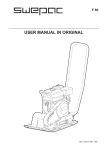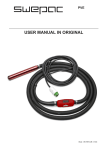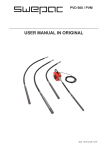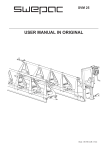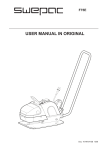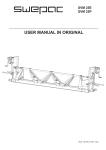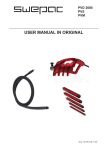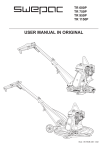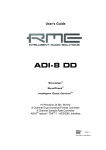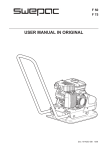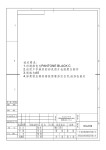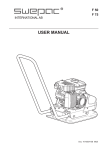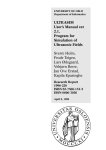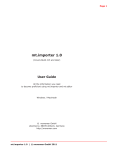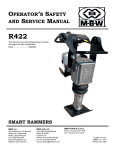Download T58 T64 T68 T84 USER MANUAL IN ORIGINAL
Transcript
T58 T64 T68 T84 USER MANUAL IN ORIGINAL Dok: 101510-GB 1514 T58 / T64 / T68 / T84 USE Swepac Tampers are suitable for compacting soil in several applications as, trenches, close to curbs, around poles and in general restricted spaces. The Tampers is also suitable to be used when the soil is mixed with clay, because of the high stroke movement. The compact design ensures good accessibility in tight spaces Swepac Tampers are designed for operation in well ventilated spaces, as for all combustions engine machines. CONTENTS Dok: 101510-GB 1514 SAFETY INSTRUCTIONS.................................... .... 3 OPERATION, PRECAUTIONS.................................. 3; 4; 5; 6 TRANSPORT, PRECAUTIONS................................. 6 MAINTENANCE, PRECAUTIONS........................... 6 STORAGE, PRECAUTIONS...................................... 6 TECHNICAL DATA.................................................... 7 SIGNS....................................................................... .. 8 DESCRIPTION........................................................ .. 9 HONDA ENGINE....................................................... 10; 11 START AND STOPPING THE ENGINE................... 12 HATZ ENGINE...................................................... .... 13 START AND STOPPING THE ENGINE....................13 OPERATING............................................................... 14 MAINTENANCE..................................................... .. 15; 16 INSTRACTIONS FOR LIFTING............................ .. 17 DIMENSIONS........................................................... . 18 TROUBLESHOOTING............................................. . 19 EC-DECLARATION OF CONFORMITY.................. 20 NOTES......................................................................... 21; 22; 23 T58 / T64 / T68 / T84 SAFETY INSTRUCTIONS To reduce the risk of serious injury or death to yourself or others read and understand the Safety and operating instruction before installing, operating, repairing, maintaining, or changing accessories on the machine. Post this Safety and operating instruction at work locations, provide copies to employees, and make sure that everyone reads the Safety and operating instruction before operating or servicing the machine. In addition, the operator or the operator’s employer must assess the specific risks that maybe present as a result of each use of the machine. Additional instructions for the engine can be found in the manufacturer’s engine manual. Personal precautions and qualifications Only qualified and trained persons may operate or maintain the machine. They must be physically able to handle the bulk, weight, and power of the machine. Always use your common sense and good judgement. Personal protective equipment Always use approved protective equipment. Operators and all other persons in the working area must wear protective equipment, including at a minimum: • Protective helmet • Hearing protection • Impact resistant eye protection with side protection • Respiratory protection when appropriate • Protective gloves • Proper protective boots • Appropriate work overall or similar clothing (not loose-fitting) that covers your arms and legs. Drugs, alcohol or medication Drugs, alcohol or medication may impair your judgment and powers of concentration. Poor reactions and incorrect assessments can lead to severe accidents or death. Never use the machine when you are tired or under the influence of drugs, alcohol or medication. Dok: 101510-GB 1514 No person who is under the influence of drugs,alcohol or medication may operate the machine. OPERATION, PRECAUTIONS DANGER Explosion hazard If a warm machine or exhaust pipe comes into contact with explosives, an explosion couldoccur. During operating with certain materials, sparks and ignition can occur. Explosions will lead to severe injuries or death. Never operate the machine in any explosive environment. Never use the machine near flammable materials, fumes or dust. Make sure that there are no undetected sources of gas or explosives. Avoid contact with the warm exhaust pipe or the bottom of the machine. DANGER Fire hazard If a fire starts in the machine, it can cause injury. If possible use an ABE-class powder extinguisher, other wise usea BE-type carbon dioxide fire extinguisher. DANGER Fuel hazard The fuel is flammable and fuel fumes can explode when ignited, causing serious injury or death. Protect your skin from contac twith the fuel.If fuel has penetratedtheskin, consult a qualified health professional. Never remove the filler cap, or fill the fueltank when the machine is hot. Fill thef ueltank outdoors or in aclean and well ventilated place, free from sparks and open flames. Fill the fuel tank at least ten meters (30 feet) from the place where the machine is to be used. Release the filler cap slowly to let pressure escape. Never over fill the fuel tank. Make sure the filler cap is screwed on when the machine is used. Avoid spilling fuel on the machine, wipe off any spilled fuel. Check regularly for fuel leaks. Never use the machine if it is leaking fuel. Never use the machine in the proximity of material that can generate sparks. Remove all hot or spark-generating devices before starting the machine. 3 T58 / T64 / T68 / T84 Work in a well ventilated area. Only store fuel in a container that is specially constructed and approved for the purpose. If the machine has an exhaust, direct the exhaust so as to reduce disturbance of dustin a dust filled environment. Consumed fuel and oil containers must be taken care of and returned to the retailer. Operate and maintain the machine as recommended in the operating and safety instructions. Never use your fingers to check for fluid leaks. Wear washable or disposable protective clothes at the worksite, and shower and change in to clean clothes before leaving the work site to reduce exposure of dust and fumes to your self, other persons, cars, homes, and other areas. WARNING Unexpected movements The machine is exposed to heavy strains during operation.If the machine breaks or gets stuck, there maybe sudden and unexpected movemen that can cause injuries. Always inspect the machine prior to use. Never use the machine if you suspect that it is damaged. Make sure that the handle is clean and free of grease and oil. Keep your feet away from the machine. Never sit on the machine. Never strike or abuse the machine. Pay attention and look at what you are doing. WARNING Dust and fume hazard Dusts and /or fumes generated or dispersed when using the machine may cause serious and permanent respiratory disease, illness, or other bodily injury (forexample, silicosis or other irreversible lung disease that can be fatal, cancer, birth defects, and /or skin inflammation). Some dusts and fumes created by compaction work contain substances known to cause respiratory disease, cancer, birth defects, or other reproductive harm. Dust and fumes in the air can be invisible to the naked eye, so do not rely on eye sight to determine if there is dust or fumes are the air. To reduce the risk of exposure to dust and fumes, do all of the following: Perform site-specific risk assessment. The risk assessment should include dust and fumes created by the use of the machine and the potential for disturbing existing dust. Wear, maintain and correctly use respiratory protection as instructed by your employer and as required by occupational health and safety regulations. Ther espiratory protection must be effective for the type of substance at issue (and if applicable, approved by relevant governmental authority). 4 Avoid eating,drinking, and using tobacco products in areas where there is dust or fumes. Wash your hands and face thoroughly as soon as possible upon leaving the exposure area, and always before eating, drinking, using tobacco products, or making contact with other persons. Comply with all applicable laws and regultions, including occupational health and safety regulations. Participate in air monitoring, medical examination programs, and health and safety training programs provided by your employer or trade organizations and in accordance with occupational health and safety regulations and recommendations. Consult with physicians experienced in relevant occupational medicine. Work with your employer and trade organization to reduce dust and fume exposure at the work site and to reduce the risks. Effective health and safety programs, policies and procedures for protecting workers and others against harmful exposure to dust and fumes should be established and implemented based on advice from health and safety experts. Consult with experts. DANGER Exhaust gas hazard The exhaust gas from the machine’s combustion engine contains carbon monoxide which is poisonous, and chemicals which cause cancer, birth defects, or other reproductive harm. Inhalation of exhaust fumes can cause serious injury, illness, or death. Never inhale exhaust fumes. Ensure good ventilation (extraction of air by fan if necessary). Dok: 101510-GB 1514 Never smoke when filling the fuel tank or when working with the machine or servicing it. T58 / T64 / T68 / T84 WARNING Projectiles Failure of the work piece, of accessories, or even of the machine itself may generate high velocity projectiles. During operating, splinters or other particles from the compacted material may become projectiles and cause personal injury by striking the operator or other persons.To reduce these risk: Use approved personal protective equipment and safety helmet, including impact resistant eye protection with side protection. Make sure that no unauthorised persons trespass into the working zone. Keep the work place free from foreign objects. If numbness, persistent recurring discomfort, burning sensation, stiffness, throbbing, tingling, pain, clumsiness, weakened grip,whitening of the skin, or other symptoms occurat any time, when operating the machine or when not operating the machine, stop operating the machine, tell your employer and seek medical attention. Continued use of the machine after the occurrence of any such symptom may increase the risk of symptoms becoming more severe and /or permanent. Operate and maintain the machine as recommended in these instructions, to prevent an unnecessary increase in vibration. WARNING Rotating blades hazards The following may help to reduce exposure to vibration for the operator: There is a risk of hands and feet getting caught by the rotating blades when the machine is running. This can cause personal injury. If the machine has vibration absorbing handles, keep them in a central position, avoid pressing the handles into the end stops. Never place your hands or feet inside the protection ring when the machine is running When the percussion mechanism is activated, the only body contact with the machine yous hould have are your hands on the handle or handles. Avoid any other contact, for example supporting any part of the body against the machine or leaning onto the machine trying to increase the feed force. WARNING Motions hazards When using the machine to perform work-related activities, you may experience discomfort in the hands, arms, shoulders, neck, or other parts of the body. Adopt a comfortable posture whilst maintaining secure footing and avoiding awkward off-balanced postures. Changing posture during extended tasks may help avoid discomfort and fatigue. In case of persistent or recurring symptoms, consult a qualified health professional. WARNING Vibrations hazards Immediately stop working if the machine suddenly starts to vibrate strongly. Before resuming the work, find and remove the cause of the increased vibrations. Participate in health surveillance or monitoring, medical exams and training programs offered by your employer and when required by law. When working in cold conditions wear warm clothing and keep hands warm and dry. See the”Noise and vibration declaration statement”for the machine, including the declared vibration values. This information can be found at the end of these Safety and operating instructions. Dok: 101510-GB 1514 Normal and proper use of the machine exposes the operator to vibration.Regular and frequent exposure to vibration may cause, contribute to, or aggravate injury or disorders to the operator’sf ingers, hands, wrists, arms, shoulders and/or nerves and blood supply or other bodyparts, including debilitating and/or permanent injuries or disorders that may develop gradually over periods of weeks, months, or years.Such injuries or disorders may include damage to the blood circulatory system, damage to the nervous system, damage to joints, and possibly damage to other body structures. Make sure that the machine is well-maintained and not worn out. 5 T58 / T64 / T68 / T84 Never grab or touch a rotating machine part. Avoid wearing clothing, neck ware or gloves that may get caught. Cover long hair with a hair net. DANGER Electrical hazard The machine is not electrically insulated. If the machine comes in to contact with electricity, serious injuries or death may result. Never operate the machine near any electric wire or other source of electricity. Make sure that there are no concealed wires or other sources of electricity in the working area. DANGER Concealed object hazard During operating, concealed wires and pipes constitute a danger that can result in serious injury. Check the composition of the material before operating. Watch out for concealed cables and pipes for example electricity, telephone, water, gas, and sewage lines. If the machine seems to have hit a concealed object, switch off the machine immediately. Make sure that there is no danger before continuing. WARNING Involuntary start Involuntary start of the machine may cause injury. Keep your hands away from the start and stop device until you are ready to start the machine. Learn how the machine is switched off in the event of an emergency. WARNING Noise hazard High noise levels can cause permanent and disablinghearing loss and other problems such as tinnitus(ringing, buzzing, whistling, or humming in the ears). To reduce risks and prevent an unnecessary increase in noise levels: Risk assessment of these hazards and implementation of appropriate controls is essential. Operate and maintain the machine as recommended in these instructions. If the machine has a silencer, check that it is in place and in good working condition. Always use hearing protection. 6 TRANSPORT, PRECAUTIONS WARNING Loading and unloading hazard When the machine is lifted by a crane and similar appliance, this can lead to injury. Use marked lifting points. Make sure that all lifting devices are dimensioned for the weight of the machine. Never remain under or in the immediate vicinity of the machine. MAINTENANCE, PRECAUTIONS WARNING Unexpected start hazard During maintenance or when changing blades on the machine, there is a risk that the engine backfires or that the machine unexpectedly starts. This applies especially when the engine is hot and if the switch is in position ON. This can result in serious personal injury. Always let the engine cool down. Always turn the switch to position OFF. Always take the cap off the spark plug. WARNING Unexpected start hazard Any machine modification may result in bodily injuries to yourself or others. Never modify the machine. Modified machines are not covered by warranty or product liability. Always use original parts, insertion tools, and accessories. Change damaged parts immediately. Replace worn components in good time. CAUTION High temperature The machine’s engine exhaust pipe, and bottom become hot during operation. Touching them can lead to burns. Never touch a hot machine. Never touch the bottom of the machine when its hot. Wait until the engine, exhaust pipe, and bottom of the machine have cooled down before carrying out maintenance work. STORAGE, PRECAUTIONS Keep the machine in a safe place, out of the reach of children and locked up. Dok: 101510-GB 1514 WARNING Trapping hazards There is a risk of neck ware, hair, gloves, and clothes getting dragged into or caught by rotating machine parts. This may cause choking, scalping, lacerations, or death. To reduce the risk: T58 / T64 / T68 / T84 TECHNICAL DATA T58 T64 Engine, petrol.....................................Honda GXR120 Engine, output..................................................2,7 kW Fuel..............................Unleaded petrol, 95-98 octane Fuel tank volume.................................................2,5 L Impact force ......................................................16 kN Weight.................................................................58 kg Ramming shoe w x l...........................190 x 280 (mm) Vibration frequency.......................................10-12 Hz Compaction depth..............................................55 cm Guaranteed sound-power level, LWA.........104,6 dB(A) Sound pressure level (at operators ear)......94,6 dB(A) Engine, petrol.....................................Honda GXR120 Engine, output..................................................2,7 kW Fuel..............................Unleaded petrol, 95-98 octane Fuel tank volume.................................................2,5 L Impact force ......................................................17 kN Weight.................................................................64 kg Ramming shoe w x l...........................230 x 280 (mm) Vibration frequency.......................................10-12 Hz Compaction depth..............................................65 cm Guaranteed sound-power level, LWA.........104,6 dB(A) Sound pressure level (at operators ear)......94,6 dB(A) T68 T84 Engine, petrol.......................................Honda GX120 Engine, output..................................................2,6 kW Fuel..............................Unleaded petrol, 95-98 octane Fuel tank volume.................................................2,5 L Impact force ...................................................17,5 kN Weight.................................................................68 kg Ramming shoe w x l...........................230 x 280 (mm) Vibration frequency.......................................10-12 Hz Compaction depth..............................................65 cm Guaranteed sound-power level, LWA.........106,6 dB(A) Sound pressure level (at operators ear)......94,6 dB(A) Engine, petrol............................................Hatz 1 B20 Engine, output..................................................3,5 kW Fuel....................................................................Diesel Fuel tank volume.................................................2,5 L Impact force ...................................................17,5 kN Weight.................................................................82 kg Ramming shoe w x l...........................230 x 280 (mm) Vibration frequency.......................................10-12 Hz Compaction depth..............................................70 cm Guaranteed sound-power level, LWA.........105,4 dB(A) Sound pressure level (at operators ear)......96,2 dB(A) FUEL and OIL RECOMMENDATIONS Hand/arm vibrations The vibration acceleration was measured in accordance with the ISO 5349 standard during operation on a graveledsurface. The measurement values were translated into the maximum daily exposure time for regular usage. For additional information about vibrations, please confer the regulation AFS 2005:15 from the Swedish Work Environment Authority, effective July 1st 2005. Measurement uncertainty ± 0.3 m/s2 in 95% of the measurements. Hand/armvibrations, m/s2 T64 6,1 T68 6,1 T84 6,1 1,3 1,3 1,3 1,3 Engine oil........................................................SAE 15W-40 Ramming cylinder oil.....................................SAE 15W-40 Dok: 101510-GB 1514 The maximum daily exposure time T58 6,1 Fuel T58 / T64 / T68..........Unleaded petrol 95-98 octane Fuel T84..................................................................Diesel 7 T58 / T64 / T68 / T84 SIGNS Warning Signs NOTE! Use only the machine´s lifting eye to lift the machine. Before use, carefully read the manual and its safety instructions so that you can handle the machine safely. Ensure that the manual is always accessible. Machine Signs 1 2 3 9 8 4 MACHINERY 5 Engine and silencer: to avoid burns or discomfort, do not touch hot engine parts when the engine is on or when the machine has recently been used. Belt drive: Keep hands, tools and other objects away from the belt drive when the machine is on to avoid injury and damage. See the safety instructions in the manual. 7 6 1. Manufacturer 2. Place, country of manufacture. 3. CE mark. 4. Model name. 5. Year of manufacture. 6. Max. engine power. 7. Max. weight. 8. Serial number. 9. Machine type Dok: 101510-GB 1514 As the sound pressure level at the operator’s ears exceeds 80 dB (A), ear protectors must be used when working with the machine to prevent hearing damage. 8 T58 / T64 / T68 / T84 DESCRIPTION 1 T58 2 T84 12 1 2 11 3 3 4 4 5 5 6 6 7 8 9 1. Throttle control 2. Guiding handle 3. Cover 4. Fuel filter 5. Air filter 6. Diesel engine 10 Dok: 101510-GB 1514 1. Throttle control 2. Guiding handle 3. Cover 4. Fuel filter 5. Air filter 6. Petrol engine 7. Crankase with below 8. Spring cylinder 9. Transport handle 10. Tamper plate 11. Roller 12. Lifting eye 9 T58 / T64 / T68 / T84 Honda engine GX 120 1; Spark plug 1 2; Engine valves 3; Engine oil/dipstick 4; Silencer 5; Air filter 2 4 6; Recoil starter 5 6 3 1 2 3 Air Filter Check The air filter must be checked at least once every working week. When working in dusty conditions, check daily. Cleaning 1.Open the air filter lock (3) and remove the paper element (2) and check that the element is undamaged. Replace damaged parts. 2. Strike the paper element against a hard object a few times to loosen any dirt. Dok: 101510-GB 1514 3. Remount back all the parts. 10 T58 / T64 / T68 / T84 Honda engine GXR 120 2 Regular Check 1 4 5 The air filter must be checked at least once every working week. When working in dusty conditions, check daily. 3 4 1; Spark plug 6 2; Engine valves 3; Engine oil/dipstick 4; Silencer 5; Air filter 6; Recoil starter 3 2 1 Cleaning the air filter, engine 1. Loosen screws (1) and remove the cover (2). Clean the dust off the cover 2. Clean the pre-cleaner (3) with cleanser and water. Saturate the precleaner in engine oil. Squeeze dry in clean absorbent cloth. 3. Clean the cartridge (4) by tapping it gently on a flat surface. NOTE! Renew a damaged cartridge. 4. Remount the filter unit in opposit order. Fuel Check Check that there is fuel in the tank. Fill up if necessary. Engine Oil Level Check Check the oil level in the crankcase every day. The oil must reach the edge of the filling hole when the machine is on a level surface. Dok: 101510-GB 1514 Oil/Fuel Leakage Check every day that the engine is not leaking oil or fuel. If a leak is discovered, the machine may not be operated until the fault has been remedied. 11 T58 / T64 / T68 / T84 START Honda engine OFF ON Off On Engine power switch Fuel valve level GX120 Open the choke gradually. Run an cold engine warm for max 5 minutes depending on the air-and engine temperature. STOPPING the engine Closed Open Choke Switch the engine to idle and let it run for a few minutes. Switch the engine power switch to “0”. Close the fuel valve level. See Daily Checks on page 10. STARTING the engine Switch the engine power switch to “1”. Open the fuel cock. Adjust the choke. If the engine is cold, close the choke completely. Do not use the choke if the engine is warm or if the air temperature is high. Start by pulling the starting handle. Pull it first until the Dok: 101510-GB 1514 mechanism engages. Then pull it hard and fast. 12 T58 / T64 / T68 / T84 Hatz engine START Hatz engine 1 5 2 3 spac106 1; Air filter 4 2; Recoil starter 3; Engine oil/dipstick 4; Oil drain screw 5; Silencer Starting the engine Start by pulling the starting handle. Pull it first until the mechanism engages. Then pull it hard and fast. Press the lever down and hold it down until the flywheel has reached its maximum RPM. Then let it go. STOPPING Switch the engine to the idle position idle, let it run for a few minutes, then switch it to stop. spac102 Air Filter Check The air filter must be checked at least once every working week. When working in dusty conditions, check daily. Cleaning 1.Remove the foam plastic element and the paper element and check that they are undamaged. Replace damaged parts. Dok: 101510-GB 1514 2. Wash the foam plastic element in liquid with a high flashpoint and let it dry properly. Dip in engine oil and squeeze dry. 3. Strike the paper element against a hard object a few times to loosen any dirt. 13 T58 / T64 / T68 / T84 OPERATING INSTRUCTIONS START Honda engine 1. Move the throttle to the working mode and the tamper will begin to move. Note! During operation, the engine must always work at full throttle (working mode). 2. Guide the tamper with guide handle. 3. Take care that the shoe hits parallel to the ground. 4. Do not fight or overpower the machine. Note! Never work on hard surfaces (solid rock, hardened concrete or such). When working in trenches always make sure that they are wide enough. When working in a narrow trench, the ramming shoe should get caught between the walls of the trench, the rammer may mis-strike and can be severely damaged. The ramming shoe may especially be damaged severely. Make certain that the rammer is steared only by using the hand grip. It should only be pushed. The rammer must not be pressed into the materials being compacted. Excessive pressure to the operation handle will lead to the unsatis factory compaction due to the fact that the jumping action is hindered. If the machine falls over while working, switch off the engine before raising it. Dok: 101510-GB 1514 5. Put the throttle in the stop mode. Fuel supply to the engine is cut off in this mode, tank ventilation is closed and the engine switch is Off. 14 T58 / T64 / T68 / T84 MAINTENANCE Every 10 hours of operation Maintenance Check and replenish fuel. Check and replenish engine oil. Check for oil leakage Check and tighten screws and nuts, if necessary. Check air cleaner elements Check ramming system lubrication with sight glass Comments The first 20 hours of operation Maintenance Change engine oiL. Clean / replace air cleaner elements. Check the engine revs. Change ramming system oil Comments See engine manual. Every 100 hours of operation Maintenance Change engine oil. Clean / replace air cleaner elements. Check the engine revs. Check and clean the spark plug. Comments See engine manual Every 500 hours of operation (At least once a year) Comments Dok: 101510-GB 1514 Maintenance Change fuel filter and clean the fuel tank. Change ramming system oil. Check the hood lock. 15 T58 / T64 / T68 / T84 MAINTENANCE - EVERY 10 HOURS OF OPERATION Check oil level in the tamper leg through the sight glass (1) The level should be at the middle of the sight glass. 1 Check and, where necessary, tighten screws and nuts. Take special care with bolted joints on the rammer foot. Keep machine clean. The machine shall always be upright when washed. Never aim a water jet directly at the cap of the fuel tank. This is especially important when using a high-pressure jet. Put a plastic bag over the filler cap of the fuel tank and secure with a rubber band. MAINTENANCE - EVERY 100 HOURS OF OPERATION Change oil (see engine manual). Check and clean the spark plug. Replace air cleaner element (see engine manual). MAINTENANCE - EVERY 500 HOURS OF OPERATION Change oil in the tamper leg. Screw out the drain plug and empty the oil into a receptacle. Save the oil in a can and dispose of it properly. Refit the plug tight, making sure that the washer seal is undamaged. Remove the sight glass and fill with fresh oil as follows. Refit the sight glass and tighten firmly. The oil level should be at the middle of the sight glass. Dok: 101510-GB 1514 Check the rubber straps on the hood. 16 T58 / T64 / T68 / T84 INSTRUCTIONS FOR LIFTING 1 Keep well clear of the hoisted machine. Use only the frame lifting hook (1) for lifting the machine. All lifting devices must be dimensioned in order to full fil all regulations. Before lifting check that ramming shoe is correctly attached and not damaged. The weight is noted on the machine data plate; see the”Machine data plate” section. Lay the machine down when switched off and not in use. Always lash the machine securely for all transportation. For moving short distances, the machine can be tilted forward so that it rests on the plastic wheels on the handle. Lift the transport handle and roll the machine forward or backward. Put the throttle in stop mode so that no fuel runs out. Dok: 101510-GB 1514 Keep your feet clear of the machine. 17 T58 / T64 / T68 / T84 C DIMENSIONS Contact surface Contact surface B E A T58 740 350 1050 370 230 220 T64 740 350 1050 370 280 220 T68 740 350 1050 400 280 220 T84 740 350 1050 400 280 2203 Dok: 101510-GB 1514 A mm B mm C mm D mm E mm Contact surface D 18 T58 / T64 / T68 / T84 TROUBLESHOOTING TROUBLE Engine stalls or does not start POSSIBLE CAUSE Insufficient fuel REMEDY Fill with gasoline, check the fuel filter Engine does not accelerate, ishard to start or runs erratically Air filter is dirty Motor oil low Clean/replace the air filter Fill with motor oil Engine overheats Motor oil low Restricted air flow Fill with motor oil Clean/replace the air filter Engine runs, but rammer does Clutch damaged not tamp Repair or replace clutch Engine running smoothly, but the tamper is uneven Repair or replace clutch Dismantle and remove oil/grease Clean shoe Replace springs Adjust engine revs. Replace fuel filter Dok: 101510-GB 1514 Clutch damaged Oil or grease on clutch Soil buildup on ramming shoe Broken or worn springs Incorrect engine revs. Fuel filter clogged 19 T58 / T64 / T68 / T84 EC-declaration of conformity Manufacturer Swepac AB Blockvägen 3 34132 Ljungby 1. Category: Tamper 2. Type: T58 T64 T68 T84 3. Engine power: T58.......................2,7kW T64.......................2,7kW T68.......................2,6kW T84.......................3,5kW The product complies with the following directives: 2006 / 42 / EG 2000 / 14 /EG 2004 / 108 / EG EN 500-1 EN 1033 ISO 5349 EN 500-4 Technical documentation held by: Dok: 101510-GB 1514 Swepac AB, Blockvägen 3 SE-34132 Ljungby Tomas Johansson / Product Engineer 20 T58 / T64 / T68 / T84 Dok: 101510-GB 1514 NOTES 21 T58 / T64 / T68 / T84 Dok: 101510-GB 1514 NOTES 22 T58 / T64 / T68 / T84 Dok: 101510-GB 1514 NOTES 23 SWEPAC AB Address Blockvägen 3, 341 32 Ljungby, Sweden, tel. +46 (0)372-156 00, fax +46 (0)372-837 41, E-mail [email protected], Internet www.swepac.se
























